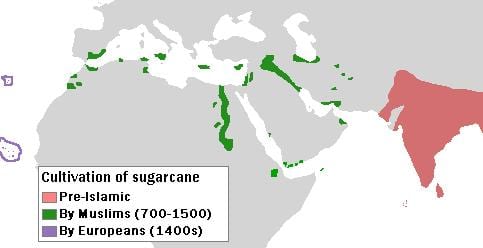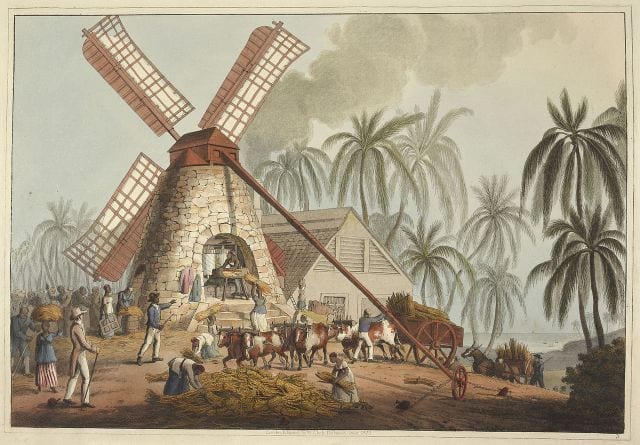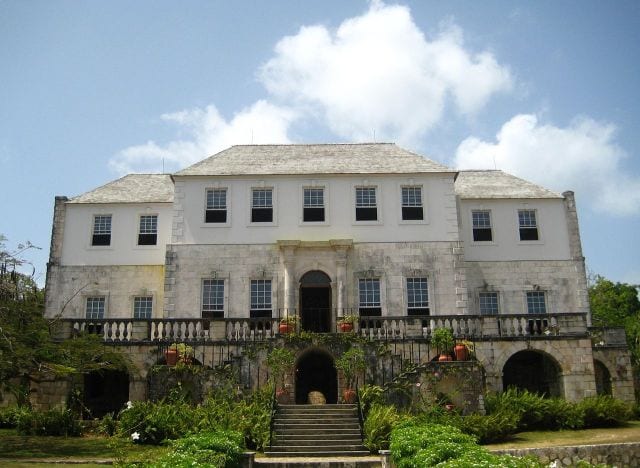
Sugar

Sugar (Saccharum officinale)
Franz Eugen Köhler, Köhler’s Medizinal-Pflanzen
Courtesy Wikimedia Commons
Introduction
Sugarcane, Saccharum officinarum, is a perennial grass (family Poaceae) that in one year grows rapidly to about 5 m tall in hot, rainy climates of the tropics and subtropics where labour is most arduous, re-growing when chopped down and harvested for use as a preservative and sweetener. Several species are cultivated and naturalized in areas outside their native habitats. Saccharum barberi originated from India and S. edule and S. officinarum from New Guinea, the latter common in cultivation (Latin officinarum – sugar of commerce). The genus name Saccharum was given by Linnaeus (Medieval Latin-saccharum, Latin-saccharon, Greek-sakkharon, Pali-sakkhara, Sanskrit-sarkara). Nowadays is available commercially in many cultivated varieties (cultivars). Over 80% of the world’s sugar comes from this source, the remainder being extracted from the bulbous beetroot-like roots of sugar beet which grows in temperate regions.
Processing
Sugarcane needs an ample supply of water and nutrient. It is planted as sets as 50 cm canes. The process of crystallizing the juice was developed in India around 500 BCE. The juice is squeezed from the canes in mills before being distilled and reduced to form a syrup that crystallizes the remaining lesser quality Brown ‘molasses’ being drained away to leave the white refined sugar. For 2-3 years, new shoots, called ratoons, are produced before the crop is exhausted. The need for clean water, not always available in the colonies, sugar refineries were often built in the port towns.
Origin & distribution

Map showing the westward diffusion of cultivated sugarcane
Pre-Islamic times (red), medieval Muslim world (green), Europeans of 15th century in Macaronesia Islands (circled in violet)
The map does not show the original dispersal from the Pacific and Polynesia to southeast Asia and China before its arrival in India. Nor later European 15th and 16th century transference to the New World
Courtesy Wikimedia Commons Bless sins Accessed 25 May 2017
The human use of sugarcane dates back thousands of years. The native species from which modern sugarcane derived probably originated in New Guinea passing from there as a commodity along the trade routes of Southeast Asia to become established in China and India. The famous Persian Emperor Darius I (c. 550–486 BCE) when he invaded India in 510 BCE described the plant as ‘the reed that gives honey without bees’ and it was introduced to Persia, probably arriving in Ancient Greece shortly after the time of Alexander the Great. It was not introduced commercially into Europe until the Middle Ages, brought to Spain by Arabs following their occupation of the Mediterranean basin in the 7th century CE. While Arab plantations were established in Crete, Cyprus, Egypt, Morocco, North Africa, Palestine, Sicily, Spain, and Syria, honey was still the major source of sweetness in western Europe.
It was possibly the knights of the First Crusade in the 11th century who first encountered sugar when they were in Syria and small quantities were imported from the Mediterranean trading hubs of Venice and Genoa. Like the spices before, sugar was, at first, a luxury good to be enjoyed and flaunted by the upper echelons of society only.
Early meagre supplies were supplemented in the 15th century when the Portuguese established the first slave plantations in Macaronesia, on the Atlantic islands Madeira, Azores and São Tomé and then the Spanish on the Canary Islands in 1480.
Prince Henry the Navigator (1394–1460) established a sugar mill on Madeira in 1420, this soon being the most productive mill in the Western hemisphere. Columbus, through his marriage to his first wife, Felipa Perestrello, had access to the nautical charts and logs that had belonged to her deceased father, Bartolomeu Perestrello, who had served as a captain in the Portuguese navy under Prince Henry the Navigator. After collecting sugar cane samples in La Gomera in the Canary Islands he introduced them to the island of Hispaniola (the first harvest in 1501) from whence it was dispersed across the Caribbean.
Columbus had returned to the New World with sugar from the Canary Islands on his second voyage of discovery in 1493, and in 1494 it was established on the West Indian island of Hispaniola. Though the native Taino peoples were essentially exterminated, the crop thrived and the first shipment of sugar arrived in Seville in 1515. By 1530 more plantations had been set up and the triangular Atlantic slave trade was in place.
Political fortunes changed and Dutch and French interests were established. But with the defeat of Spain by England in 1588 British companies and interests began to dominate the West Indies with settlements on St Kitts (1624), Barbados (1627), Antigua (1632) and elsewhere the capture of Jamaica from the Spanish in 1655 proving critical for the region. Various experimental crops were grown in trials including cotton, ginger, indigo, and limes as well as the popular tobacco. Sugar performed well and gradually replaced tobacco and cotton (whose prices were declining) as the major economic crop. Like tobacco this was a labour-intensive crop and the black plantation slaves were part of the lucrative triangular Atlantic trade that brought manufactured goods like guns, cloth, salt, and ornaments from Europe to Africa where the slaves were then transported to the New World, sold to plantation owners, then the products of the plantations returned to Europe to repeat the cycle. By 1660 Barbados was the world’s major producer employing over 50,000 slaves to be superseded after the 1740s by Jamaica and Saint Domingue (Haiti) then in the mid-20th century by Cuba. Jamaica developed a reputation for undesirables frequenting the inns and brothels and becoming famous for their piracy and in the 18th century sugar ‘barons’ built luxurious mansions on their plantation estates. But life was always precarious with the ever-present danger of fires, droughts, cyclones, disease, slave revolts, and attack from native peoples or a foreign country. However, for 150 years Britain would reap the financial benefits of these sugar plantations.
By 1750 the price of sugar had plummeted to fall within the range of the common man to become an expected ingredient at meal time.

The Mill Yard – Antigua
Grinding sugar cane in a windmill
Image from Ten Views in the Island of Antigua, in which are represented the process of sugar making, and the employment of the negroes
Originally published in London by Thomas Clay, 1823. Drawing by William Clark 1823
Courtesy Wikimedia Commons. Jheald Accessed 25 May 2017
Plant commentary & sustainability analysis
Sugar was one of the major horticultural crops in a period of intensifying changes in plant geography after European colonial expansion. Sugar provides us with an excellent example of the process of cultivated plant globalization through history. Sugarcane species interbreed, the major commercial cultivars being complex hybrids. Being so long in cultivation the true wild ancestors of commercial sugar are unknown but those probably originated in the Pacific (?New Guinea c. 6000 BCE). Plant selections passed into Polynesia, Southeast Asia, then China, and on to India. From here plants were taken by Muslim traders to the Mediterranean, notably the Iberian Peninsula which had access to the islands of Macaronesia and later, via the Atlantic, the New World.
During the European Age of Discovery (end of the 15th to the 18th century) plants were transferred from the Spanish Canary Islands and Portuguese Madeira to the New World where slave plantations in the Caribbean would provide supply Europe with its favourite sweetener. This was part of a ‘Columbian exchange’ of plants between the Old and New Worlds, except in this case the plants transported across the Atlantic from Europe had originated in the Pacific region. Today the geographic distribution of commercial sugar reflects its demand on a global scale since it is grown in tropical, subtropical, and warm temperate regions of Africa, Eurasia, Australia, the Americas, and oceanic islands.Inevitably the plant has naturalized in areas outside its native range. In 2015 the world’s largest producers were, in order: Brazil, India, China, Thailand, Pakistan, Mexico, Colombia, Indonesia, Philippines, United States (FAO Statistics).

Rose Hall – Montego Bay, Jamaica
Plantation estate mansion in the Jamaican Georgian style and built in the 1770s
Courtesy Wikimedia Commons
Urban Walnut Accessed 25 May 2017
Sugar feeding into the economy in many indirect ways, through the secondary products of rum, molasses, and falernum, the sweetening of tea and coffee and so on. The commercial and social benefits of sugar for Europeans and others must be balanced against the negative impacts of colonialism which included the extermination or decimation of native peoples, partly by force but mostly through the introduction of devastating European diseases since they had no immunity. Building great civilizations and empires through increasingly sophisticated social organization depends ultimately on intensive work. The European Age of Discovery, exploration, and colonial expansion produced a phase of rapid economic growth (coupled with its associated population growth) now known as the Great Divergence, a period in which European globalization, culminating in the British Empire, would take control of world trade. Some of the revenue that enhanced this process came from the profits generated by horticultural crops, among the best known being tobacco, tea, coffee, cotton, rubber, and sugar. The commercial benefits of sugar were generated by black West African labour in the cruel and oppressive tropical conditions of the European sugar plantations until the abolitionist movement gathered momentum in the late 18th century (slavery was banned in Denmark in 1792, France 1794, Britain in 1804, America in 1863). Over the course of about 150 years it is estimated that the trade in slaves and indentured labour totalled about 20 million people. Money from plantation sugar helped fund the establishment of the Royal Botanic Gardens Kew, public monuments like the Tate Gallery in London, and the growth of maritime cities like Liverpool and Bristol[1] and combined with the revenues obtained from other horticultural crops would add momentum to the gathering Industrial Revolution in Britain.
Sugar has found a modern use as cane ethanol, a biofuel, along with the vegetable waste known as bagasse. Today sugarcane and sugar beet face competition from corn syrup extracted from maize and sorghum. . Successful British merchants made wealthy by sugar would oversee the ports of Bristol, Liverpool, and London.
With some justification sugar has been called ‘One of the world’s most indulgent and least necessary crops’[2] and we can sympathize today in the light of the abundance of type 2 diabetes, obesity, heart disease, and tooth decay.
Media Gallery
Where Did Sugar Come From? – Addicted To Pleasure – BBC
BBC Studios – 2015 – 4:09
The History of Sugar- A Tale neither short nor sweet
Traveling Cuervo – 2020 – 8:21
The Journey of Sugar: Neither Short nor Sweet
National History Day – 2016 – 10:00
*—
First published on the internet – 1 March 2019
Rose Hall – Montego Bay, Jamaica
Plantation estate mansion in the Jamaican Georgian style and built in the 1770s
Courtesy Wikimedia Commons – Urban Walnut – Accessed 25 May 2017


